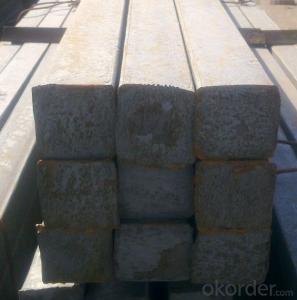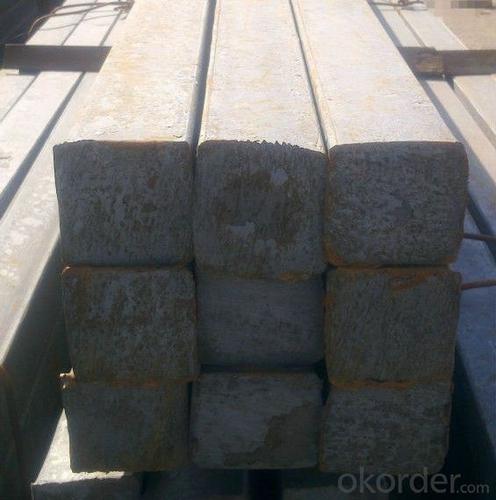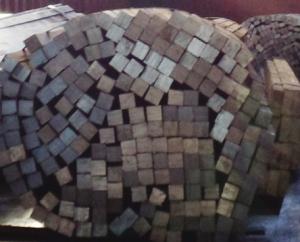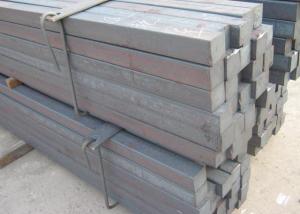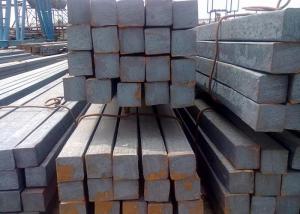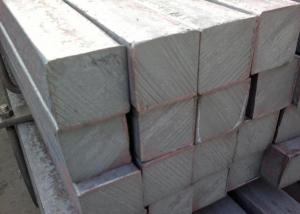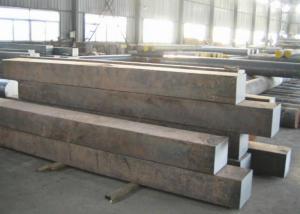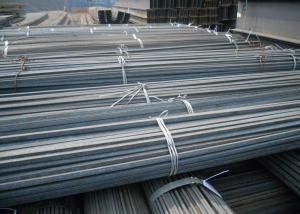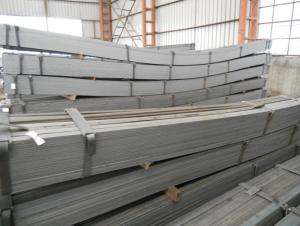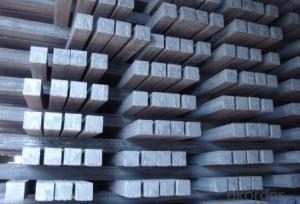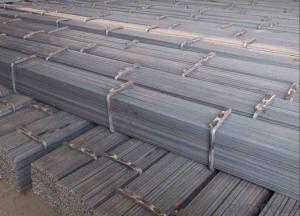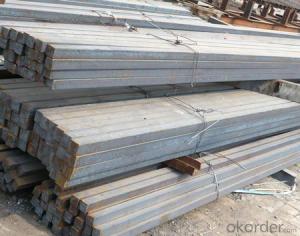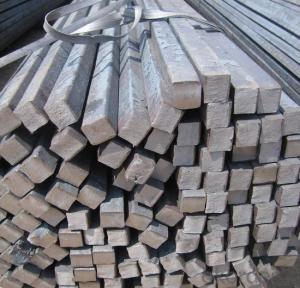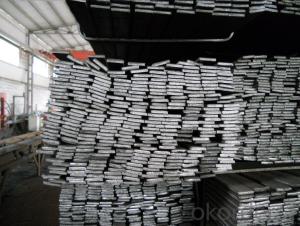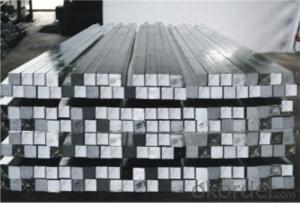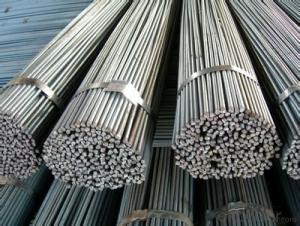High Quality GB Standard Steel Square Bar
- Loading Port:
- Tianjin
- Payment Terms:
- TT OR LC
- Min Order Qty:
- 25 m.t
- Supply Capability:
- 10000 m.t/month
OKorder Service Pledge
OKorder Financial Service
You Might Also Like
Product Description:
-Standard: GB,
-Grade: Q195 or equivalent.
-Chemical Composition:
Standard | Grade | Element (%) | ||||
GB | Q195 | C | Mn | S | P | Si |
0.06~0.12 | 0.25~0.50 | ≤0.050 | ≤0.045 | ≤0.30 | ||
Measures of HR Square Bar (small measures):
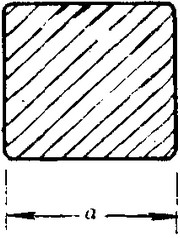
(Section of HR Square Bar)
-Length of a side and Theoretical weight of Square Bar.
Length of a side(mm) | Theoretical weight(kg/m) | Length of a side(mm) | Theoretical weight(kg/m) |
7 | 0.385 | 22 | 3.80 |
8 | 0.502 | 24 | 4.52 |
9 | 0.636 | 25 | 4.91 |
10 | 0.785 | 26 | 5.30 |
11 | 0.950 | 28 | 6.15 |
12 | 1.13 | 30 | 7.06 |
13 | 1.33 | 32 | 8.04 |
14 | 1.54 | 34 | 9.07 |
15 | 1.77 | 36 | 10.17 |
16 | 2.01 | 38 | 11.24 |
17 | 2.27 | 40 | 12.56 |
18 | 2.54 | 42 | 13.85 |
19 | 2.82 | 45 | 15.90 |
20 | 3.14 | 48 | 18.09 |
21 | 3.46 | 50 | 19.63 |
Notes:
1, The theoretical weights in the list, base on the density of 7.85 g/cm3.
2, Formula for theoretical weight of Square bar: (length of a side)2 * 0.00785
3, The numbers with *mean that they are not regular or we don’t offer them.
-Regular length of Square Bar:
Steel | Length of a side (mm) | Length of steel (m) |
Normal steel | < 25 | 4~10 |
> 25 | 3~9 | |
Steel of high quality | All measure | 2~6 |
Tool steel >75 | 1~6 |
Usage/Applications of HR Square Bar:
-The Square Bar is normally used as structure steel.
-Row material for other structure steel like steel angles, channels, I-beams, H-beams, etc…
Packaging & Delivery of HR Square Bar:
-Packing Detail: The products can be packed in bundles by steel wires.
-Marks: We make tag marks and color marks. The tag marks with white background and red company logo will be tied up to each bundle of the products. The information is usually including basic information of products and company and other information requested by customers. As for color marks, we will paint both ends of bundles to make sure that it will be more convenient for customers to distinguish them from other products.
-Delivery Detail: 30~45 working days after receive buyer’s T.T. or L/C.
Transportation:
-The products can be delivered by bulk vessel or by container. As for container, products with the length of 6m will be loaded in 20’ container, with 9m or 12m, in 40’ container.
-The maximum quantity of loading of container is 25 tons.
-The products are usually transported to the nearest port from the production place.
- Q: Can a steel square be used for checking the squareness of a router base plate?
- Yes, a steel square can be used for checking the squareness of a router base plate. A steel square is a precise and accurate tool that can be used to measure and verify the right angles of various objects. To check the squareness of a router base plate, simply place the steel square against the edge of the base plate and observe if it aligns perfectly with the sides of the square. If there is any gap or misalignment, it indicates that the base plate is not perfectly square. This can be useful for ensuring the accuracy and precision of router cuts and ensuring that the base plate is properly aligned with the router bit.
- Q: What are some common measurements that can be taken with a steel square in welding?
- Some common measurements that can be taken with a steel square in welding include determining angles, checking for squareness, measuring and marking straight lines, and confirming perpendicularity.
- Q: How do you use a steel square to check for plumbness in a post?
- To use a steel square to check for plumbness in a post, you would hold the square against the side of the post, ensuring that the 90-degree angle of the square is flush with the side. Then, align the vertical edge of the square with the top edge of the post. If the post is plumb, the square's vertical edge will be perfectly aligned with the post's vertical edge. If there is any deviation, it indicates that the post is not plumb and adjustments need to be made.
- Q: Can a steel square be used for checking the squareness of a door frame opening?
- A door frame opening can be checked for squareness using a steel square. The steel square, also called a framing square or carpenter's square, is a versatile tool commonly used in carpentry and construction. It has a shape of a right angle, with one arm longer than the other, making it suitable for measuring angles and checking the squareness of objects. To check the squareness of a door frame opening, position the steel square against the inside corner of the frame. Ensure that the long arm aligns with one side of the frame, while the shorter arm aligns with the other side. If the frame is perfectly square, the edges of the square will fit perfectly against both sides of the frame. However, if the frame is not square, there will be a gap between the square and one or both sides of the frame, indicating the need for adjustments. Using a steel square is a reliable and precise way to check the squareness of a door frame opening. It enables the identification of any discrepancies and allows for necessary adjustments to be made, ensuring proper fit and functionality of the door.
- Q: What are the different types of steel squares available?
- There exists a variety of steel squares, each crafted for specific purposes and applications. Among the most frequent types are: 1. The Try Square: A straightforward, L-shaped square, usually featuring a 90-degree angle, employed for marking and verifying right angles. 2. The Combination Square: This square type possesses a ruler blade affixed to the handle, enabling measurements and marking of angles other than 90 degrees. It often includes a level and a scribe, enhancing its versatility. 3. The Framing Square: Also known as a carpenter's square, this square possesses a lengthier blade, typically measuring 24 inches or more, and is utilized in framing and construction work. It showcases both a 90-degree angle and a 45-degree angle, facilitating accurate marking and cutting of rafters and stairs. 4. The Speed Square: A compact and adaptable square commonly employed in carpentry and roofing. Its triangular shape incorporates a lip on one side, which can be used as a guide for swift and precise measurements. 5. The Engineer's Square: This square is meticulously designed for engineering and machining applications, providing heightened precision. It is often crafted from hardened steel and features a 90-degree angle, a long blade, and a shorter, thicker handle for enhanced stability. 6. The Workshop Square: These squares are larger in size and typically employed in metalworking and fabrication. They are available in various dimensions and possess thicker blades to ensure increased rigidity and accuracy. 7. The Rafter Square: Also referred to as a roofing square, this square is specifically created for measuring and marking angles utilized in roof construction. It includes markings for common roof pitches and aids in determining the correct angle for cutting rafters. These examples merely scratch the surface of the diverse range of steel squares available. Each square fulfills a distinct purpose across various industries, guaranteeing precise and accurate measurements and markings.
- Q: How do you use a steel square for creating accurate half-lap joints?
- To use a steel square for creating accurate half-lap joints, follow these steps: 1. Measure and mark the desired length of the half-lap joint on both pieces of wood. 2. Place the steel square on one of the marked lines, aligning one edge of the square with the mark. 3. Draw a line along the other edge of the square, extending it to the end of the wood piece. 4. Repeat this process on the other piece of wood, ensuring the lines are parallel. 5. Use a saw to carefully cut along the marked lines, ensuring the cuts are straight and accurate. 6. Test-fit the two pieces together to check the accuracy of the joint. Make any necessary adjustments if the fit is too tight or loose. 7. Once satisfied with the fit, glue or fasten the joint together securely.
- Q: How do you use a steel square to measure the height of a window frame?
- In order to measure the height of a window frame using a steel square, the following steps should be followed: 1. Begin by positioning the steel square vertically against one side of the window frame, ensuring its alignment with the wall and parallelism with the ground. 2. Adjust the position of the square vertically until its edge aligns with the top of the window frame, while still maintaining its flushness against the wall. 3. Once the square is aligned with the top of the window frame, firmly hold it in place. 4. Consult the scale on the steel square to determine the measurement. Ensure that you are using the appropriate unit of measurement, as the scale is typically marked in inches or centimeters. 5. Take note of the measurement where the top edge of the window frame aligns with the scale on the steel square. This will provide you with the height of the window frame. It is important to remember to take accurate measurements and repeat the process on the opposite side of the window frame for consistency verification. Additionally, measuring multiple times is always recommended to ensure precision.
- Q: How do you use a steel square to determine the slope of a gutter?
- In order to determine the slope of a gutter using a steel square, the following steps should be followed: 1. Begin by measuring the width of the gutter using the outer edges of the steel square. Make sure that the square is firmly pressed against the gutter. 2. Proceed by positioning one side of the steel square against the bottom of the gutter, ensuring that it is level. The other side of the square should extend vertically towards the top edge of the gutter. 3. Verify that the steel square is perfectly vertical by using a level. If necessary, make adjustments. 4. Once the steel square is aligned correctly, examine the measurement markings on the square. The vertical side of the square indicates the rise or fall, while the horizontal side represents the run or distance. 5. Take note of the measurement where the horizontal side of the square intersects with the top edge of the gutter. This measurement will provide you with the rise or fall of the gutter. 6. To calculate the slope, divide the measurement of the rise or fall by the width of the gutter. This will yield the slope ratio, which can be expressed as a percentage or a ratio (e.g., 1:100). Utilizing a steel square to determine the slope of a gutter is an effective technique as it enables precise measurements and guarantees the proper installation of the gutter for efficient drainage.
- Q: Can a steel square be used for checking the squareness of a fence?
- To verify if a fence is square, one can employ a steel square. This multipurpose tool, commonly referred to as a framing square or carpenter's square, is frequently utilized in carpentry and woodworking to ensure precision and squareness. It comprises a 90-degree angle on one side and a 45-degree angle on the other, making it well-suited for assessing the squareness of corners and angles. By positioning the steel square against the corners or edges of the fence, one can determine if they form a perfect 90-degree angle. If the steel square fits snugly and aligns flawlessly with the fence, it signifies that the fence is square. Conversely, the presence of any gaps or misalignment indicates the necessity for adjustments to achieve squareness. Thus, a steel square serves as a dependable tool for verifying the squareness of a fence.
- Q: How do you measure angles with a steel square?
- To determine the angles of an object or material using a steel square, you may follow these instructions: 1. Position the steel square alongside the material or object whose angle you wish to measure. 2. Align one of the steel square's edges with one side of the desired angle. 3. Examine the scale or markings on the steel square. Typically, one side of the steel square includes a protractor scale. 4. Locate the zero or 90-degree mark on the scale and ensure it aligns with the reference edge of the steel square. 5. Observe the angle created by the other side of the desired angle and the edge of the steel square. 6. Determine the measurement on the scale where the other side of the angle intersects. 7. Record or remember the obtained measurement, which represents the angle of the material or object. Always secure the steel square firmly against the object or material to prevent any inaccuracies. Moreover, if the angle exceeds the steel square's direct measurement capacity, you can employ trigonometry or alternative methods to calculate the angle based on the acquired measurements.
Send your message to us
High Quality GB Standard Steel Square Bar
- Loading Port:
- Tianjin
- Payment Terms:
- TT OR LC
- Min Order Qty:
- 25 m.t
- Supply Capability:
- 10000 m.t/month
OKorder Service Pledge
OKorder Financial Service
Similar products
Hot products
Hot Searches
Related keywords
